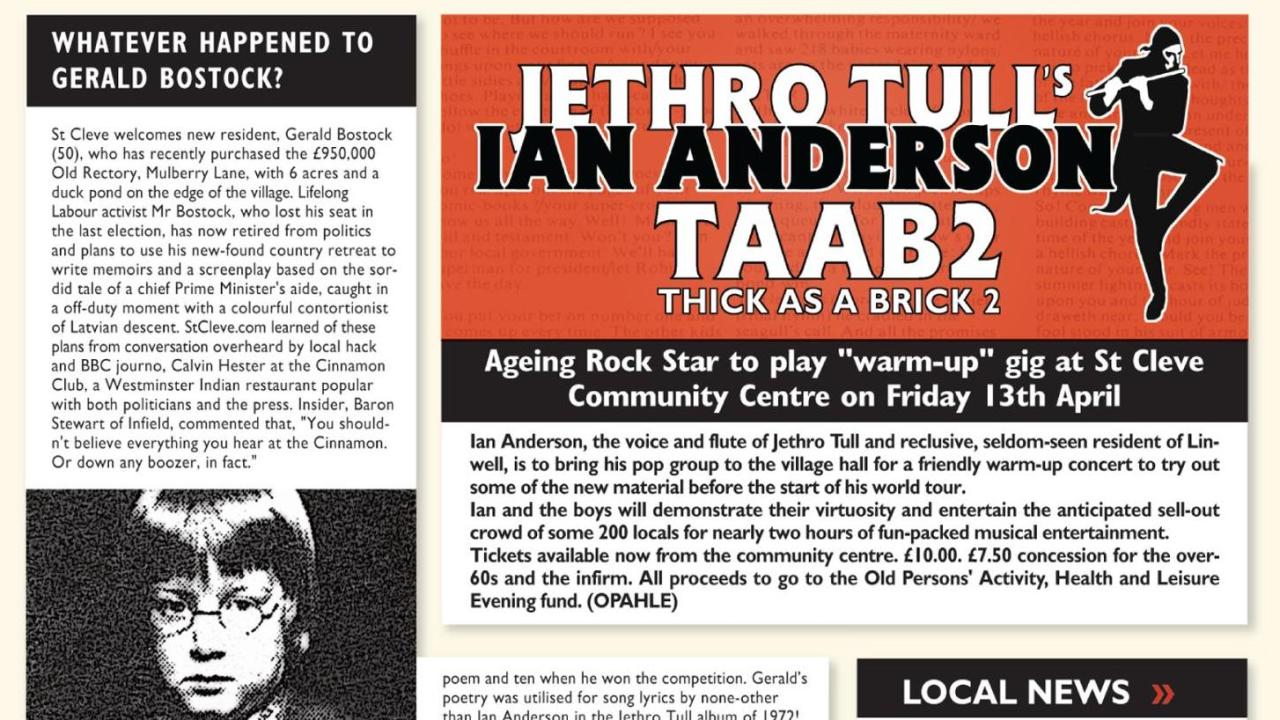You can trust Louder
Some of you might recall that in 1964 there was an acclaimed television documentary called Seven Up. This followed the lives of seven-year-olds from different social strata. During subsequent decades, the cameras have returned to see how their lives have developed and changed. In many ways, this is what Ian Anderson is doing here.
To mark the 40th anniversary of Jethro Tull’s classic 1972 concept album Thick As A Brick, Anderson has imagined the way that Gerald Bostock – the fictitious precocious schoolboy whose controversial poem supposedly inspired the lyrics for that album – might have grown up, and the twists and turns which might have faced and shaped him throughout the last four decades.
Now, Anderson could have easily been a victim of his own success with this project, constrained by expectations which will always be associated with Thick As A Brick. He could have simply fallen into the trap of making this sound too much like the original record, or conversely removing it so far that he’d have been accused of cashing in on the cachet of that iconic record. But he has avoided both of these dilemmas. Instead, he has allowed himself a considerable musical and lyrical freedom, while also remaining true to the spirit of 1972. The story itself gave a huge opportunity for imagination and plotline creativity, because it isn’t tied to anything in the past. This is Anderson’s interpretation of the possible ways Bostock’s life could have unfolded. And he’s also used the character as an allegory to look at the way the world in general has changed and shifted over the past 40 years.
It’s a tribute to Anderson’s intelligence, pragmatism and innate sense of theatricality that you actually get caught up in the lyrics, and start to realise some of the criticisms aimed at the way we’ve chosen to let others dictate how we pattern our lives. Religion, politics and social indifferences are all addressed here. But not in the world-weary way of someone who feels everything was so much better in the 70s. No, he chooses to be satirical yet objective, while never losing sight of the fact this has to be focused on Gerald Bostock’s turbulent story.
None of this would really matter if the music was a disappointment. But, thankfully, this is never even close to being the case. Given Anderson’s acute respect for his own past, it was obvious he’d set out to do something that was mindful of what had gone before, while also steering clear of repetition or mimicry. The result is a satisfying, robust musical journey. In effect one 53-minute long piece that’s split into movements, this serves as the soundtrack to Bostock’s tale, while also standing alone.
The ambience here does bring to mind the original Thick As A Brick, because much of this was recorded live and also because it has the same instrumentation as was used back then. There’s also cunning use of recurring themes, to ensure that you realise everything is linked. The performances of the musicians are of the highest calibre. John O’Hara on keyboards and Florian Opahle on guitar both have their chances to shine, which they take advantage of wholeheartedly. And inevitably, there are flourishes of flute that colour the soundscape at pertinent moments.
Because this entire album is intended to be taken as one single track, it’s the overall ebb and flow that matters rather than any individual peaks. But the dramatic punctuations serve to take the atmosphere across the emotional spectrum, from melancholy to wit, and a sense of worth. Some might suggest that Anderson’s voice has lost a little of its timbre over the years. But this is surely to be expected at his time of life. Besides, he still makes every note and line sound clear and convincing. Very much the driving force of the whole project, you feel the man’s zest and vitality pulsing throughout the album. Of all people, he is aware of the reverence with which Thick As A Brick is regarded, and has ensured that its heritage is never damaged here.
Sign up below to get the latest from Prog, plus exclusive special offers, direct to your inbox!
Of course, this wouldn’t be complete without a new edition of the famed St. Cleve Chronicle & Linwell Advertiser. This was exclusively given away with Prog issue 24. But in-keeping with the times, this is also now online at www.stcleve.com too.
It’s rare that any sequel can be said to have captured the tone and command of what went before, yet stand proud in its own right. Anderson, though, has done just that here. We can only imagine whether he’s plotting Thick As A Brick 3!
Malcolm Dome had an illustrious and celebrated career which stretched back to working for Record Mirror magazine in the late 70s and Metal Fury in the early 80s before joining Kerrang! at its launch in 1981. His first book, Encyclopedia Metallica, published in 1981, may have been the inspiration for the name of a certain band formed that same year. Dome is also credited with inventing the term "thrash metal" while writing about the Anthrax song Metal Thrashing Mad in 1984. With the launch of Classic Rock magazine in 1998 he became involved with that title, sister magazine Metal Hammer, and was a contributor to Prog magazine since its inception in 2009. He died in 2021.


